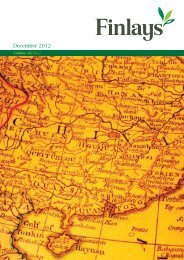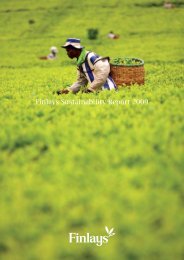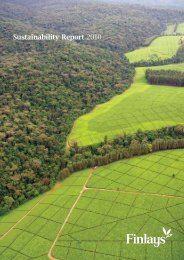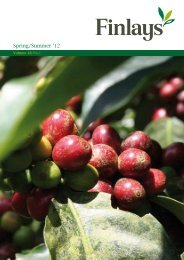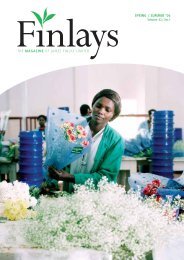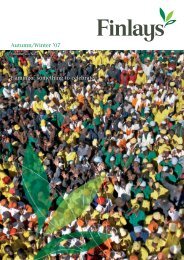Create successful ePaper yourself
Turn your PDF publications into a flip-book with our unique Google optimized e-Paper software.
4<br />
View from the MD’s Desk Rupert Hogg<br />
The decision to make this move has not<br />
been taken lightly. <strong>Finlays</strong> is an old and<br />
venerable Scottish company, established<br />
as long ago as 1750, only five years after<br />
the battle of Culloden. During much of<br />
the ensuing 250 years the company<br />
has played a prominent role in the civic<br />
and commercial affairs of the city of<br />
Glasgow as well in the communities of<br />
Catrine and Deanston.<br />
However, we have not had a Scottish-based<br />
operational business for a decade and the<br />
larger of those former businesses were<br />
closed or sold in the decades prior<br />
to that. It is also the case that many of<br />
the smaller businesses that were started<br />
during the same period, such as Flowers,<br />
Tea Trading and Tea Extracts, have grown or<br />
evolved considerably to become significant<br />
businesses in their own right and have real<br />
prospects for rapid growth.<br />
First steps into China: the new joint venture tea extracts<br />
plant at Nanjing takes shape. Tony Barcroft (r) is seen here<br />
with George Chan (l), Director <strong>Finlays</strong> Hong Kong and<br />
David Jiang, Chairman of the Damin International Group.<br />
There is much going on at present, both within James Finlay<br />
and the broader markets in which we operate; I will make<br />
mention of some of these trends later in this article. However,<br />
without question, the most important piece of news that I have<br />
to report is tinged with sadness: that is the fact that the Head<br />
Office and Glasgow operations of James Finlay Limited are to<br />
move to London as of the middle of next year.<br />
These businesses are now led and managed<br />
from London. In addition, as some of the<br />
articles in this edition may illustrate, many<br />
of the competitive and consumer trends to<br />
which the individual group companies<br />
identify and respond now require a far<br />
greater degree of coordination across the<br />
Group than has been the case in the past.<br />
Thus, the driving thrust behind the decision<br />
to move the head office closer to some of<br />
our subsidiaries is underpinned by the<br />
desire to improve our ability to coordinate<br />
and communicate internally and therefore<br />
to improve the products and services that<br />
we offer our customers externally.<br />
That is the rationale behind the decision to<br />
move the head office to London and that is<br />
what we intend to achieve by so doing.<br />
However, none of this diminishes the fact<br />
that the move represents the end of an era<br />
and that, more importantly, it is likely to<br />
mean redundancies for the great majority of<br />
the current team that have worked in the<br />
Glasgow office and contributed so much to<br />
<strong>Finlays</strong>. I can only state that the Directors<br />
and Shareholders appreciate this and that<br />
the writing of this article offers me the<br />
opportunity to publicly thank those<br />
concerned for that contribution and for<br />
their continued support until the transition<br />
is complete.<br />
I hope that the reader will notice that this<br />
edition of <strong>Finlays</strong> Magazine has a new look<br />
and that the traditional tea leaf motif has<br />
evolved too. These changes result from a<br />
re-branding exercise that is described<br />
elsewhere in this edition (page 6).<br />
While the outcome may be visually striking,<br />
the exercise itself is but a logical step in a<br />
more fundamental process of change<br />
within <strong>Finlays</strong>.<br />
The first objective has been to move<br />
towards a functional and divisional<br />
structure and away from the Group’s<br />
traditional geographic basis. This process is<br />
incomplete as yet but, as an indication,<br />
several of the subsidiary businesses now<br />
have Managing Directors who are<br />
responsible for all of the activities of their<br />
division on a global basis, a much simpler<br />
and more customer-focused proposition.<br />
The second objective, to which I have<br />
already referred, comes from within the<br />
Group itself: the need for the Group to be<br />
more cohesive and coordinated in its<br />
approach to the market and to our major<br />
customers on issues that impact us all and<br />
which are important to that wider customer<br />
base. From a communications perspective,<br />
the inference of such trends is obvious; we<br />
need a common look and feel across the<br />
Group and we need to become more<br />
uniform and consistent in the way in which<br />
we present ourselves. I believe that this<br />
exercise has managed that evolution well<br />
and injected a desirable dose of freshness<br />
and modernity to our ‘look’ in the process.<br />
<strong>Finlays</strong> has a fine record for social and<br />
environmental responsibility; I hope that<br />
what we do on the ground demonstrates<br />
that there is real substance behind such a<br />
claim. To a great degree, the Fairtrade<br />
accreditation scheme, of which many<br />
consumers are aware, acknowledges these<br />
credentials. All of our flower farms and<br />
some of our tea estates have either obtained<br />
or are in the final stages of obtaining






